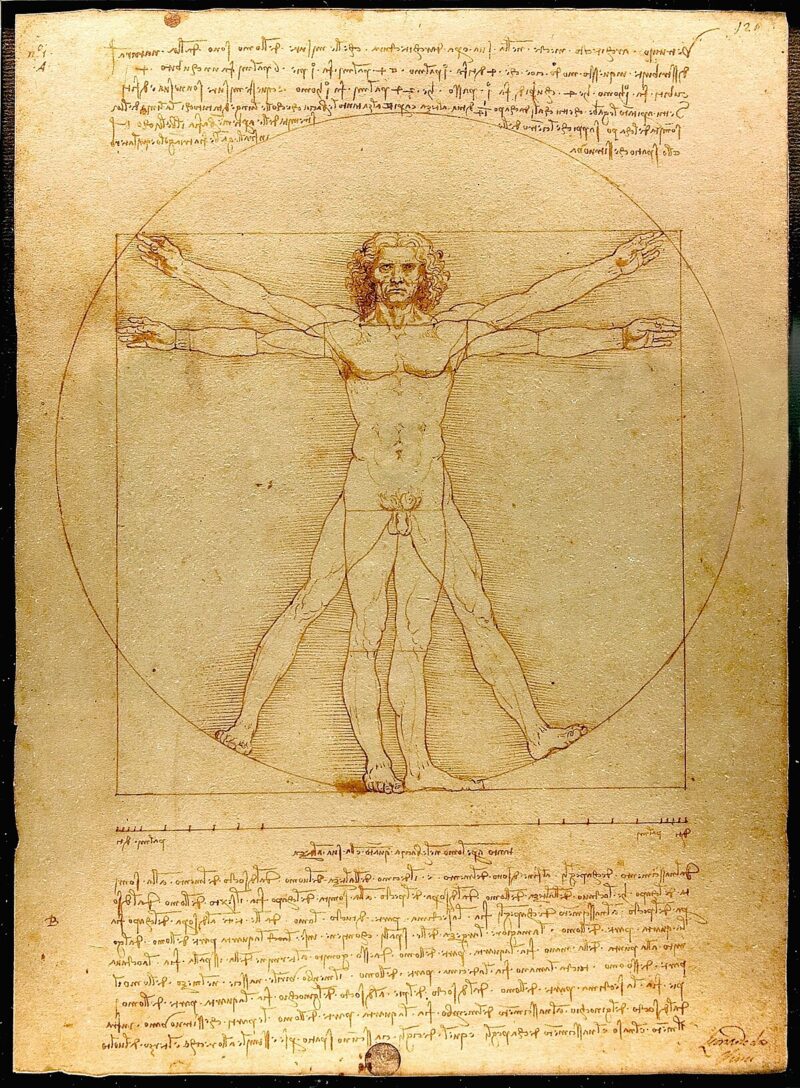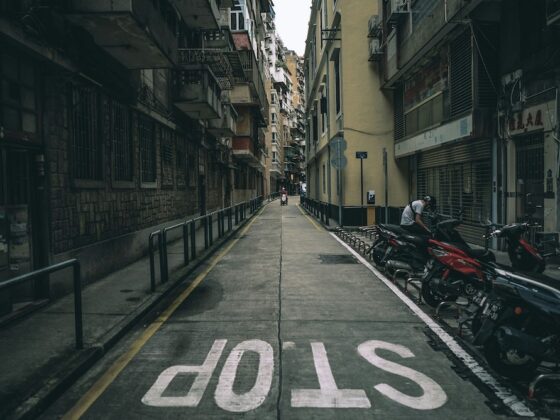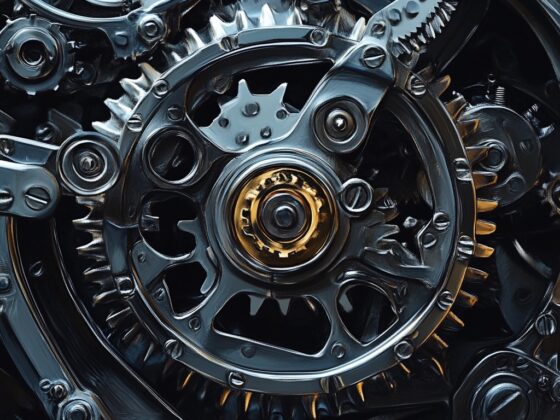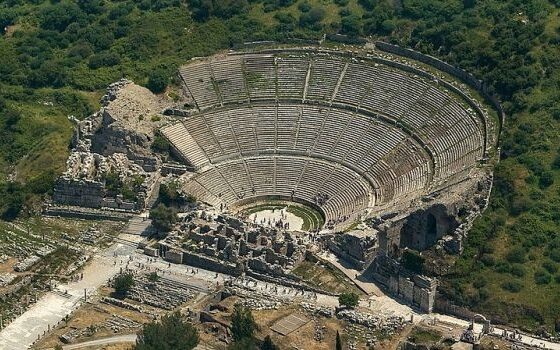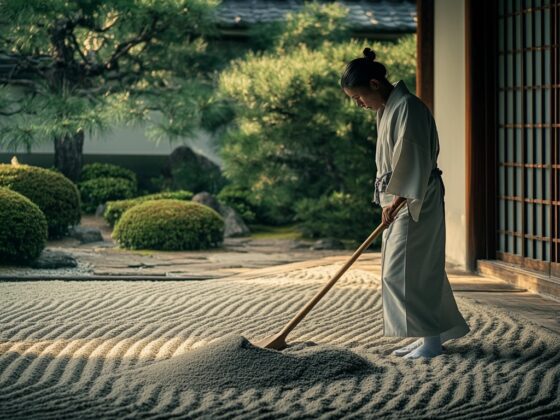The Vitruvian Man | Italian: Luomo vitruviano; originally known as Le proporzioni del corpo umano secondo Vitruvio. The proportions of the human body according to Vitruvius
Drawn in ink on paper by Leonardo da Vinci in about 1490 represents ideal human body proportions. Its inscription in a square and a circle comes from a description by the ancient Roman architect Vitruvius in Book III of his treatise De architectura. Yet, as it has been demonstrated, Leonardo did not represent Vitruvius’s proportions of the limbs but included those he found himself after measuring male models in Milan. While the drawing is named after Vitruvius, some scholars today question the appropriateness of such a title. The image demonstrates the blend of mathematics and art during the Renaissance and demonstrates Leonardo’s deep understanding of proportion. In addition, this picture represents a cornerstone of Leonardo’s attempts to relate man to nature.
Encyclopaedia Britannica online states, Leonardo envisaged the great picture chart of the human body he had produced through his anatomical drawings and Vitruvian Man as a cosmografia del minor mondo (cosmography of the microcosm). He believed the workings of the human body to be an analogy for the workings of the universe.
According to Leonardo’s preview in the accompanying text, written in mirror writing, it was made as a study of the proportions of the (male) human body as described in Vitruvius De Architectura, which reads:
For the human body is so designed by nature that the face, from the chin to the top of the forehead and the lowest roots of the hair, is a tenth part of the whole height; the open hand from the wrist to the tip of the middle finger is just the same; the head from the chin to the crown is an eighth, and with the neck and shoulder from the top of the breast to the lowest roots of the hair is a sixth; from the middle of the breast to the summit of the crown is a fourth. If we take the height of the face itself, the distance from the bottom of the chin to the under side of the nostrils is one third of it; the nose from the under side of the nostrils to a line between the eyebrows is the same; from there to the lowest roots of the hair is also a third, comprising the forehead. The length of the foot is one sixth of the height of the body; of the forearm, one fourth; and the breadth of the breast is also one fourth. The other members, too, have their own symmetrical proportions, and it was by employing them that the famous painters and sculptors of antiquity attained to great and endless renown.
Similarly, in the members of a temple there ought to be the greatest harmony in the symmetrical relations of the different parts to the general magnitude of the whole. Then again, in the human body the central point is naturally the navel. For if a man be placed flat on his back, with his hands and feet extended, and a pair of compasses centered at his navel, the fingers and toes of his two hands and feet will touch the circumference of a circle described therefrom. And just as the human body yields a circular outline, so too a square figure may be found from it. For if we measure the distance from the soles of the feet to the top of the head, and then apply that measure to the outstretched arms, the breadth will be found to be the same as the height, as in the case of plane surfaces which are perfectly square.
I have taken Vitruvian Man as the centerpiece image for Wealthness to represent Perfect YOU.
Centered upon the spot where I feel the soul lies, is the symbol for infinity to represent the Infinite Power of YOU.
KA MATE
Kikiki! Kakaka! Let your valor rise! Let your valor rage!
Kauana kei waniwania taku tara Well ward off these haunting hands
kei tarawahia, kei te rua i te kerokero! while protecting our wives and children!
He pounga rahui te uira For thee, I defy
ka rarapa ketekete kau ana the lightning bolts of hell
To peru kairiri mau au e koro e! while my enemies stand there in confusion!
Hi! Ha! Ka wehi au ka matakana,O God to think I would tremble
ko wai te tangata kia rere ure tirohanga to a pack of wolves seeing fear, or running away,
nga rua rerarera because they would surely fall in the pit of shame
nga rua kuri kakanui i raro! Aha ha! as food for the hounds who chow down in delight! Oh, what in the name
Ka mate, ka mate! ka ora! ka ora! Tis death! tis death! Tis life! tis life!
Ka mate! ka mate! ka ora! ka ora! Tis death! tis death! Tis life! tis life!
Tenei te tangata puhuruhuru This is the hairy man
Nana nei i tiki mai whakawhiti te ra Who summons the sun and makes it shine
A, upane! ka upane! A step upward, another step upward!
A, upane, ka upane, whiti te ra! A step upward, another the Sun shines!
These are the immortal words of the Haka called out to opposing teams at the start of every New Zealand All Blacks game.
New Zealand is a tiny place at the top of the world with a population the size of a small town, yet they dominate world rugby and have done so for over a hundred years. They have a 77% winning record in test match rugby, and are the only international men’s side to have secured more wins than losses against every opponent since their international debut in 1903.
The Haka is an institution and loved by fans of all sides across the globe. But, most are entirely misinformed. Most think the Maori dance is performed to intimidate the opposition, it’s not.
The Haka is performed to stir the soul, to ignite passion and to get the body to release that intangible energy ready for the battle ahead. When you watch an All Black in that moment you see the look in his eye, you see the veins pop and the pupils dilate. The quivering energy is whipped into a tumult of ions as the cyclone roars through their bodies creating one, indomitable mass.
This energy runs through all things. When harnessed within the body it pushes us on to great and surprising feats. In the East it has been recognized for thousands of years and is known simply as Qi (pronounced chi). In the West it has been known about since the seventies and was introduced to us as The Force in Star Wars!
Now I’m just an ordinary guy from a dreary carpet town in the middle of England. Factories and hard drinking, low paid working men. I grew up street fighting, smashing windows in derelict buildings and stealing milk from terraced house door steps. Think Peaky Blinders!
I’m not proud of my background and left the town as soon as the opportunity presented itself. When I look inside I’m not proud of the person I nearly was but I scrubbed up.
Now I say this because I’m forging into the realms of what I would normally feel is the domain of weirdos! This isn’t the stuff of everyday men (and ladies). When I see someone sitting on a rock, legs impossibly crossed and humming like a fucking fat bubble bee, I do think, what a nutter!
So yes this is weird-ish, not weird at all to many yet it is the missing element from our journey so far.
If I’ve done my job you should be prepared in mind and body for a better life but the crucial part of the trifecta is the soul.
An impossibly difficult concept to grasp, something that has been vigorously debated since man barbecued his first pterodactyl So I’m going to give it a go!
When ordinary people decide to step out and be part of something big, that’s when they become extraordinary.
Soul Song
The Pacific Maori have a rich and beautiful culture that was almost wiped out by The Machine.
They talk about Mana:
It is honour. To have mana is to have great authority, presence or prestige.
It is respect. Mana instils reverence and admiration. Mana respects others too.
It is power. A person with mana is spiritually powerful, influential and courageous, yet humble.
For some, mana is a legacy, handed down by generations of tupuna (ancestors). For others, it is bestowed on them for their great words and deeds.
Mana is who we are as a people and as a nation: it embodies our culture, our history, our beliefs.
Mana is sacred. It is complex. It touches the very soul.
